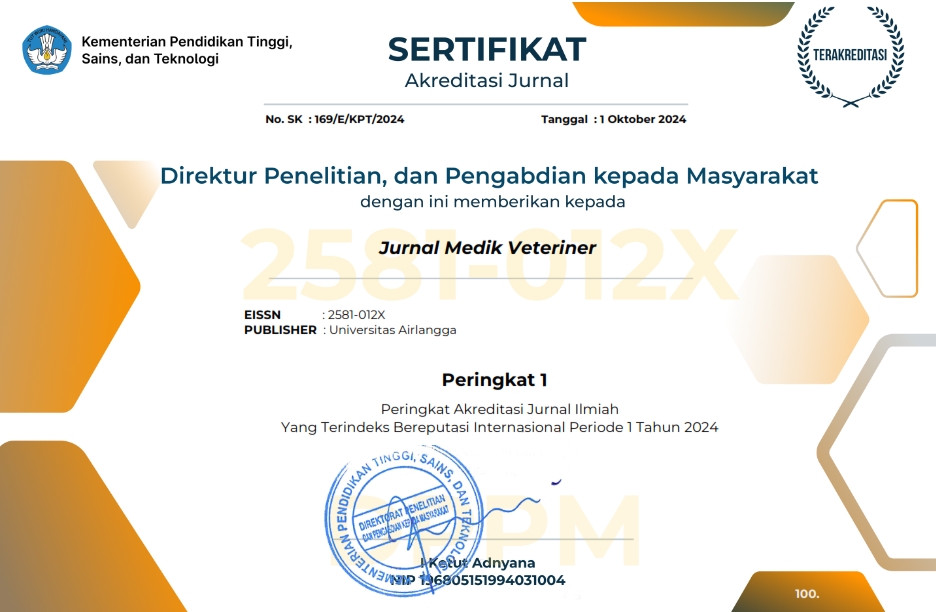Antibacterial of Cinnamon Bark (Cinnamomum burmannii) Essential Oil Against Methicillin-Resistant Staphylococcus aureus
Downloads
Al-Dhubiab, B. E. (2012). Pharmaceutical applications and phytochemical profile of Cinnamomum burmannii's. Pharmacognosy Review, 6(12), 125-131.
Andersson, D. I., & Hughes, D. (2010). Antibiotic resistance and its cost: is it possible to reverse resistance?. Nature Reviews Microbiology, 8(4), 260-271.
Awang, A. F. I. B., Deny, S., & Muhammad, T. (2013). Antimicrobial activity and synergic effect of Cinnamomum burmannii's essential oil & its isolated compound (cinnamaldehyde). CAMS, Malaysia, 29-30 Dec 2013. pp: 26-29.
Bisignano, C., Giovanna, G., Antonella, S., Erminia, L. C., Giuseppe, C., Flavio, A. F., Peter, Q. T., Angela, A., Domenico, T., Luigi, M., & Giuseppina, M. (2019). Study of the lipid profile of atcc and clinical strains of Staphylococcus aureus in relation to their antibiotic resistance. PMCID, 24(7), 1276.
Chon, J., Kidon, S., & Saeed, K. (2017). Methicillin-Resistant Staphylococcus aureus (MRSA) in food-producing and companion animals and food products. Intech, pp: 47-102.
Cristani, M., Manuela, D., Giuseppina, M., Francesco, C., Maria, G. S., Dorotea, M., Vincenza, V., Giuseppe, B., Antonella, S., & Domenico, T. (2007). Interaction of four monoterpenes contained in essential oils with model membranes: implications for their antibacterial activity. Journal Agricultural Food Chemistry, 55(15), 6300-6308.
Daker, M., Voon, Y. L., Gabriel, A. A., Mun, F. Y., & Mariam, A. (2013). Inhibitory effects of cinnamomum burmannii blume stem bark extract and trans-cinnamaldehyde on Nasopharyngeal carcinoma cells; synergism with cisplatin. Experimental and Therapeutic Medicine, 5(6), 1701-1709.
Davidson, P. M., & Taylor, T. M. (2007). Food microbiology "chemical preservatives and natural antimicrobial compounds”. 3th Edition. ASM Press, pp: 713-745.
Dwi, W. K., Tyasningsih, W., Praja, R. N., Hamid, I. S., Sarudji, S., & Purnama, M. T. E. (2018). Deteksi Antibodi Brucella pada Sapi Perah di Kecamatan Purwoharjo Kabupaten Banyuwangi dengan Metode Rose Bengal Test (RBT). Jurnal Medik Veteriner, 1(3), 142-147.
Fikri, F., Purnama, M. T. E., Saputro, A. L., & Hamid, I. S. (2018). Identifikasi Escherichia coli dan Salmonella spp pada Karkas Sapi di Rumah Potong Hewan di Banyuwangi dan Resistensi Terhadap Antibiotika. Jurnal Sain Veteriner, 36(1), 123-128.
Halim, S. V., Rika Y., & Eko, S. (2017). Penggunaan antibakteri golongan carbapenem pada pasien dewasa rawat inap sebuah rumah sakit swasta di Surabaya. Jurnal Farmasi Klinik Indonesia, 6(4), 267-281.
Homenta, H. (2016). Infeksi biofilm bacterial. Jurnal eBm, 4(1), 1-11.
Jia, P., Xue, Y. J., Duan, X. J. & Shao, S. H. (2011). Effect of cinnamaldehyde on biofilm formation and sara expression by Methicillin-resistant Staphylococcus aureus. Letter Applied Microbiology, 53(4), 409–416.
Kartikasari, A. M., Hamid, I. S., Purnama, M. T. E., Damayanti, R., Fikri, F., & Praja, R. N. (2019). Isolasi dan identifikasi bakteri Escherichia coli kontaminan pada daging ayam broiler di rumah potong ayam Kabupaten Lamongan. Jurnal Medik Veteriner, 2(1), 66-71.
Mith, H., Remi, D., Veronique D., Abdesselam Z., Georges, D., & Antoine C. (2014). Antimicrobial activities of commercial essential oils and their components against food-borne pathogens and food spoilage bacteria. Food Science and Nutrition, 2(4), 403-416.
Papp-Wallace, K. M., Endimiani, A., Taracila, M. A., & Bonomo, R. A. (2011). Carbapenems: past, present, and future. Antimicrobial Agents and Chemotherapy, 55(11), 4943–4960.
Parisa, N., Rahma, N. I., Ella A., Mariana, & Riana, S. P. R. (2019). Antibacterial activity of cinnamon extract (Cinnamomum burmannii) against Staphylococcus aureus and Escherichia coli in vitro. Biology Scence Medicine, 3(2), 19-28.
Plumeriastuti, H., Budiastuti , Mustofa, H. E., & Budiarto. (2019). Identificatio n of bioactive compound of the essential oils of Cinnamomum burmannii from several areas in indonesia by gas chromatography–mass spectrometry method for antidiabetic potential. Natural Journal Physiology Pharmacy Pharmacology, 9(4), 279-283.
Pradika, A. Y., Chusniati, S., Purnama, M. T. E., Effendi, M. H., Yudhana, A., & Wibawati, P. A. (2019). Uji Total Escherichia coli pada Susu Sapi Segar di Koperasi Peternak Sapi Perah (KPSP) Karyo Ngremboko Kecamatan Purwoharjo Kabupaten Banyuwangi. Jurnal Medik Veteriner, 2(1), 1-6.
Shan, B., Yi-Zhong C., John D. B., & Harold, C. (2007). Antibacterial properties and major bioactive components of cinnamon stick (Cinnamomum burmannii): activity against foodborne pathogenic bacteria. Journal Agricultural Food Chemistry, 55(14), 5484−5490.
Shang, W., Yifan, R., Ying, Z., Yi, Y., Qiwen, H., Zhen, H., Jizhen, Y., Huagang, P., Kun, X., Li, T., Shu, L., Junmin, Z., Ming, L., Xiaomei, H., Xuhu, M., & Xiancai, R. (2019). β- Lactam antibiotics enhance the pathogenicity of Methicillin Resistant Staphylococcus aureus via SarA-Controlled Lipoprotein-Like cluster expression. mBio, 10(3), 1-14.
Sharma, P., James, P. M., & Albert, R. (2013). Ten highly effective essential oils inhibit growth of Methicillin Resistant Staphylococcus aureus (MRSA) and Methicillin Sensitive Staphylococcus aureus (MSSA). International Journal Pharmacy Pharmaceutical Science, 5(1), 52-54.
Shen, S., Tiehua, Z., Yuan, Y., Songyi, L., Jingyue, X., & Haiqing, Y. (2015). Effects of cinnamaldehyde on Escherichia coli and Staphylococcus aureus membrane. Food Control, 47, 196-202.
Sulistyaningrum, N. F. (2016). Pola kuman dan uji sensitivitasnya terhadap antibiotik pada penderita infeksi luka operasi (ILO) di RSUD Dr Woewardi Periode Januari-Juli 2015. Naskah Publikasi Universitas Muhammadiyah Surakarta.
Tamhid, H., Arde, T. N., & Aditya, F. 2017. Antibacterial activity of ampicillin against mrsa bacteria after combined with cinnamon oil vapor using gaseous contact method. Jurnal Ilmiah Farmasi, 13(2), 69-76.
Vanderhaeghen, W., Tineke, C., Connie, A., Jo Vicca, Katleen, H. and Patrick, B. 2010. Methicillin-resistant Staphylococcus aureus (MRSA) ST398 Associated with clinical and subclinical mastitis in belgian cows. Veterinary Microbiology, 144(2), 166-171.
Vangalapat, M., Sree, S. N., Surya, P. D. V., & Sumanjali, A. (2012). A review on pharmacological activities and clinical effects of cinnamon species. RJPBCS, 3(1), 653-663.
Vasconcelos, N. G., Croda, J., & Simionatto, S. (2018). Antibacterial mechanisms of cinnamon and its constituents: a Review. Microbiology Pathology, 120, 198-203.
Weerakkody, N. S., Nola C., Mark S. T., & Gary A. D. (2010). In vitro antimicrobial activity of less-utilized spice and herb extracts against selected food-borne bacteria. Food Control, 21, 1408–1414.
World Health Organization. (2014). Antimicrobial resistance global report on surveillance.
World Health Organization. (2017). Global priority list of antibiotic-resistant bacteria to guide research, discovery, and development of new antibiotics.
Zhang, Z., Xiaoyu, L., Yifei, W., Pingping, J., & Siew, Y. Q. (2016). Antibacterial activity and mechanism of cinnamon essential oil against Escherichia coli and Staphylococcus aureus. Food Control, 59, 282-289.
Authors who publish in this journal agree to the following terms:
1. The journal allows the author to hold the copyright of the article without restrictions;
2. The journal allows the author(s) to retain publishing rights without restrictions;
3. The legal formal aspect of journal publication accessibility refers to Creative Commons Attribution-NonCommercial-ShareAlike 4.0 International License (CC BY-NC-SA).






11.jpg)




















